In just 17 more days, EA Sports College Football 25 will be released fully to the public. In case you missed it, we covered the gameplay deep dive from early in June that provided finer details of controlling the players during games. Not long ago, EA also released a sights and sounds deep dive which wasn’t quite as thorough but covered topics such as:
- Showcasing the most authentic run outs for teams on to the field.
- Detailed motion capture for historical traditions in and around the field.
- 40 team mascots and 10 live real animals in the game.
- Addition of touchdown and turnover props.
- Crowd noise from 41 different stadiums.
- All 134 fight songs recorded by musicians with EA, plus 180 more college gameday songs.
- 170 different crowd themes (whiteouts, checkerboard patterns, etc.) with appropriate pageantry props.
- Dynamic attendance with larger crowds the more you win.
- Dozens of hand signals (but no Horns Down).
- More than 220 gameday crowd chants.
- Chris Fowler/Kirk Herbstreit announcing on games of the week, conference championships, and all playoff games. Rece Davis/Jesse Palmer/David Pollack announce all other games. In total, they recorded over 68,000 different lines.
That stuff sounds great, but the biggest area to cover–the one area that many of us in our 30’s and 40’s especially grew up feasting on in the past–is college football dynasty mode. Now this game mode has its own deep dive and we break down the details:
FULL DYNASTY DEEP DIVE BLOG CLICK HERE.
There’s so much info, I’ll just do a million bullet points.
The 3 pillars of dynasty are 1) Build Your Coach, 2) Build Your Program (recruiting), and 3) Deliver the World of College Football. The latter has to do with customizing your dynasty, like altering conferences.
Playing games earns XP for your coach and Coach Points to upgrade their coaching ability.
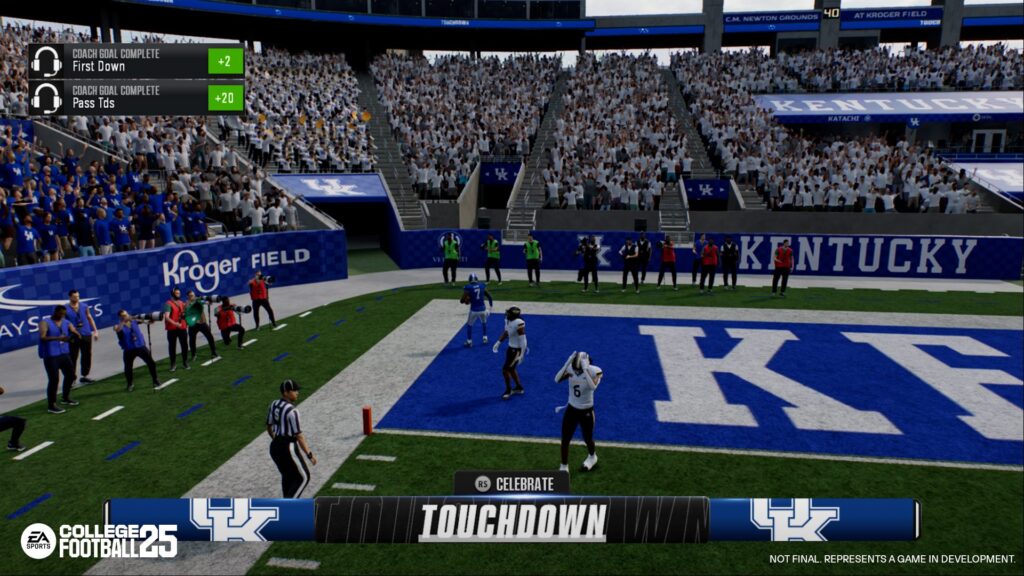
XP top left after scoring a touchdown.
XP coaching categories cover areas such as 1st round draft pick, beating a top 25 team, signing a 5-star prospect, being ranked in the top 10 for the week, passing for 4,000 yards, and many more.
All coaches start with a basic archetype in recruiting, motivation, or scheme. You can become an expert in these categories or try to be a hybrid coach. Other archetypes like program builder or CEO can be unlocked later as you progress.
You can buy another archetype, for example in order to unlock the recruiter you have to spend 50 XP and have signed a pair of top 5 classes.
There are 50 different coaching abilities, each with 4 tiers, with positional specialization included.
An example would include a scheme guru coach upgrading fast tempo offense at 4 levels to have players fatigue slower, increase the delay for defenders looking to the sidelines, composure boosts for 1st downs, ability to see defense’s coverage shell in hurry up.
Program builder and CEO are only available for head coach’s and include boosts to roster management, program culture, home field advantage, and recruiting pipelines.

Coaching abilities screen.
Coordinators progress on their own with their abilities. Their abilities stack together with the head coach for extra boosts.
You can start out as a head coach or coordinator with contract expectations including winning x games, winning a conference, making the playoff, and winning a National Championship. You can turn off firing within dynasty.
Coach prestige ranges from A+ to F with expectations adjusted by school.
If you are offered a contract extension from your current school it is auto accepted to protect you from simming and missing the extension. You can leave via the coaching portal at any time.
The last 20 years of school’s records and results are visible at the start of the game and then update as you progress through your dynasty.
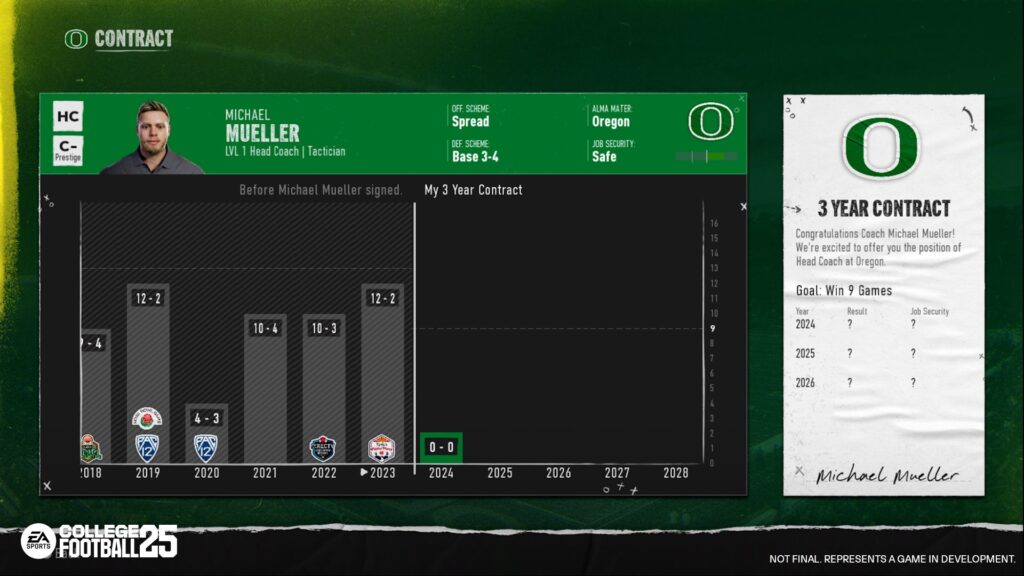
A contract renewal.
Coaching carousel is spread out over 5 weeks from conference championship week until the bowl games. This is the timeframe when you can fire your assistants.
Each new job offer shows the school’s preferences, what happened to their previous coach, and who the top candidates are for the opening.
In the hiring process, school’s will evaluate based on coaching prestige, coaching level, scheme fit, archetype, and recruiting pipeline for a ‘school fit score.’
All coordinators have 2 year contracts that auto-renew, unless you fire them or they leave for another school/job.
Recruiting works in 3 stages: discovery, pitch, and close.
Dynasty deep dive video.
Players verbally commit but are not officially part of the class until National Signing Day.
There are ‘My School Grades’ for each team with 14 categories including, playing time, playing style, championship contender, program tradition, campus lifestyle, stadium atmosphere, pro potential, brand exposure, academic prestige, conference prestige, coach prestige, coach stability, athletic facilities, and proximity to home.
Signing new players affects starters and backups on your current roster who may feel compelled to transfer.
Bud Elliott’s blue chip ratio is in the game as part of the championship contender formula for recruiting.
Some school grades update dynamically throughout the season and will affect your ability to recruit. You will be sent a weekly summary of your school grades.

Stanford, not a contender.
More than 3,500 recruits are generated each cycle. Every recruit will have 3 motivations they care about forming their ‘ideal pitch.’
One of those 3 motivations may be a ‘dealbreaker’ and if you do not meet this to their satisfaction they will not talk to you.
There are 50 different recruiting pipelines and they are broken up by region. For example, Florida is broken up into north, central, and south Florida while metro Atlanta is its own pipeline.
Based on the last 10 year’s of data, each school has a tiered ranking system for their strongest and weakest pipelines throughout the country. These pipelines do not change throughout dynasty play, interestingly.
Recruits narrow down their list of teams from open, to top 8, to top 5, and then top 3. There will be a recruiting summary each week so you can cut ties and/or move forward with a recruit if they’ve made changes to their top teams.
35 is the maximum number of players you can have on your recruiting board at any given time.
Team prestige determines how many recruiting hours you have available and you are given more hours in the off-season and pre-season when you’re not preparing for games. Recruits max out at 50 hours of recruiting on them, unless you unlock the ‘always be ‘crooting’ boost which increases this to 70 hours.

Recruiting board.
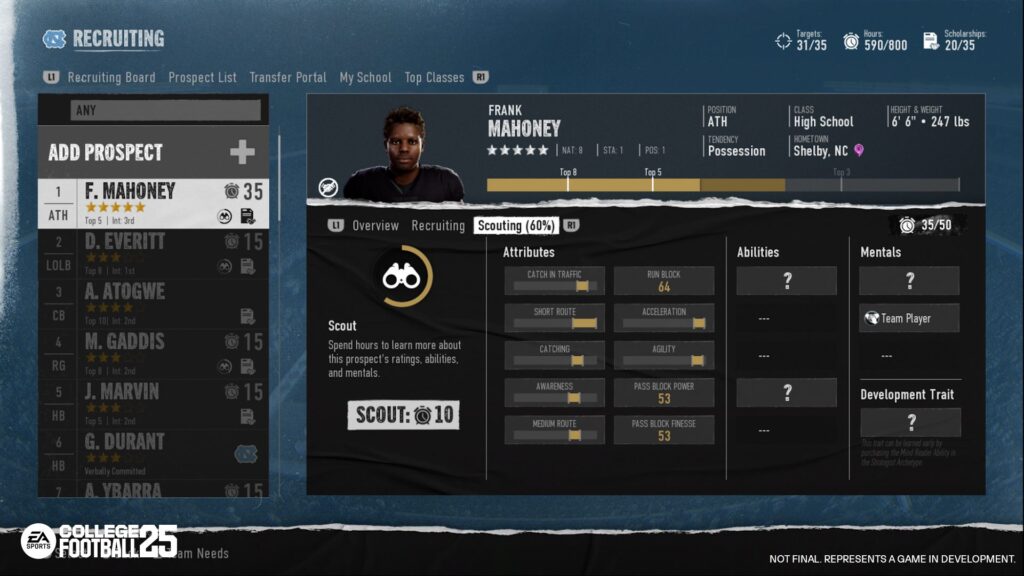
Scouting a player page.
Scouting a player sometimes unlocks their full attribute, other times its partially revealed. A player’s developmental trait is not unlockable in the scouting process. Only the ‘mind reader’ ability can figure this out prior to NSD when a prospects is on their official visit.
There is a gem/bust system that helps to uncover the lesser visibility recruit or show that a 4-star is actually a 3-star prospect.
There are 5 actions in stage 1 of recruiting: offer scholarship, search social media, DM the player, contact family and friends, and send the house.
There is a soft sell and hard sell option. From the blog: “After selecting a pitch type, you will then select your pitch. Each pitch is a collection of three motivations and there are 20 pitches in total. For example, the Sunday Bound pitch sells a recruit on your school being a championship contender, its conference prestige, and your school’s track record of sending kids to the next level.”
An official visit can only be scheduled when a prospect is in your top 5 and you’ve offered a scholarship. Recruits can only visit during a bye week or a home game. An official visit costs 40 recruiting hours. You can only schedule 4 official visits to campus per week.
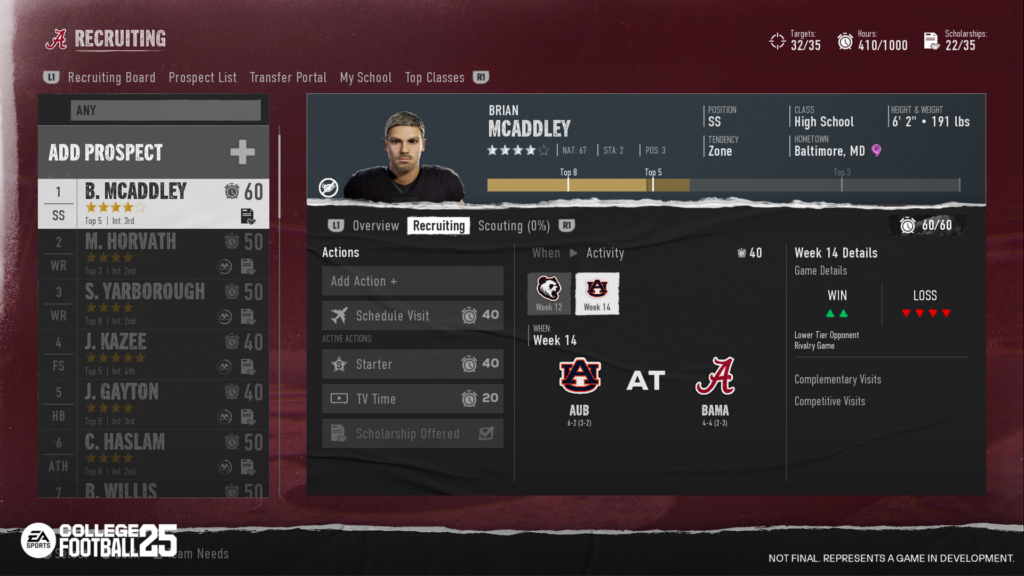
Scheduling an official visit.
‘Gameday stakes’ provide upside or downside for a recruit on their visit based on your opponent and the outcome. The position of players visiting at the same time matters and can have more upside or downside.
There are 14 activities for a recruit to do on an official visit.
Players are on your roster who have a Dealbreaker are more likely to leave if that part of your school grade drops and they are a higher overall type of player.
Coaching changes can affect coaching prestige levels which makes it more likely players will transfer. You can persuade a player to stay if they’ve decided to leave and it’s based on their overall and your coaching prestige. Higher overall players will be more difficult to convince. The better your coaching prestige the more persuasion attempts you will have.
Players can be encouraged to transfer, although this will not include incoming true freshmen.
The transfer portal players will have a new recruiting page similar to when they were in high school, including carrying over their dealbreaker. Higher rated players will start out with a top 5 schools so if you’re not included you cannot recruit them to transfer.
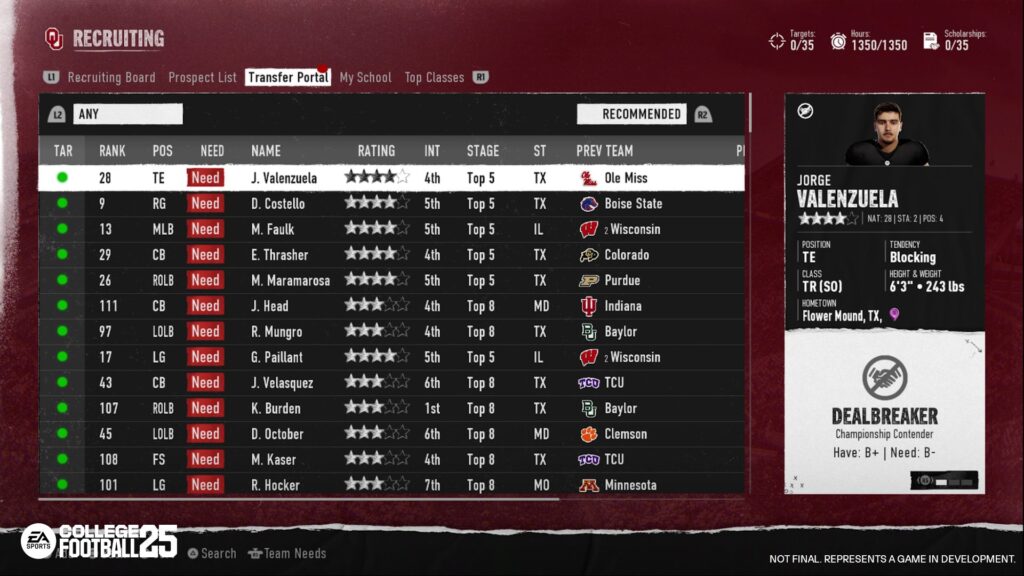
A transfer portal page.
Early Signing Day will occur right before bowl season and National Signing Day occurs 7 weeks after the National Championship. Most recruits will sign during ESD. Transfers will sign later on NSD.
Players can change position after NSD, and there is a position change spreadsheet that shows their projected new overall, their new archetype, depth chart rank, and the number of players at a position of change.
There are 4 different development traits: Normal, impact, star, and elite.
Players can develop their skill groups all the way up to 10 levels, although not every player will have that 10 available in their development.

Power player development for Judkins.
The College Football Playoff poll will come out in the first week of November, in addition to the bowl projections.
You can decrease any conference to a minimum of 4 teams and increase a league to a maximum of 20 teams. Schools can be moved to independent, but lose the 1st round bye in the playoffs.
League rules can be edited to include divisions or not, division names, annual conference games, if there’s a conference championship game, and the location of a conference championship game.
Conference logos and jersey patches update as teams are moved around to new leagues.

James Madison in the ACC.
Season kickoff games such as the Duke’s Mayo Classic and Vegas Classic are in the game.
Crowd themes (whiteouts, etc.) appear in week 1, for rivalry games, or if you’re playing the game of the week.
A max of 16 TeamBuilder teams can be included in a private online dynasty. Any new TeamBuilder team has to replace a current FBS team.
You can choose to redshirt players in the pre-season. You can track which players have participated in 4 games to try and keep a redshirt and those 4 games can be played at any point throughout the season.
There will be a Heisman Watch updated every week. Individual national awards are in the game, in addition to pre-season and post-season All-American/Conference teams, and players of the week at the national and conference levels.
The record book features season stats, career stats, coaching stats, and all are tracked at the national and conference level.


Tomahawk pride stickers.
Dynamic helmet stickers are in the game with a blank helmet starting each season.
Both online and offline dynasty last for 30 seasons.




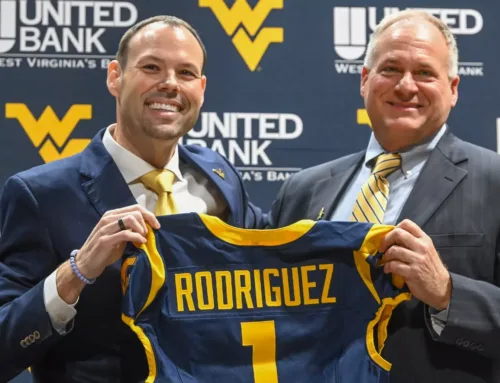
NotTheExpert has a good (hour-long) breakdown on YouTube as well: https://youtu.be/TRG-bjSVuLQ?si=JkpiyKv64FsM11C8. I love that the FCS teams are based on youtubers’ custom dynasty teams like NTE’s own UGF Pandas!
Still going to wait to see how the gameplay gets reviewed a month or so after release but I continue to be mostly encouraged about the general direction of the game!
The amount of productivity lost to this game is going to be large enough to affect GDP numbers.
Can anyone take my wife & 3 kids for a while?